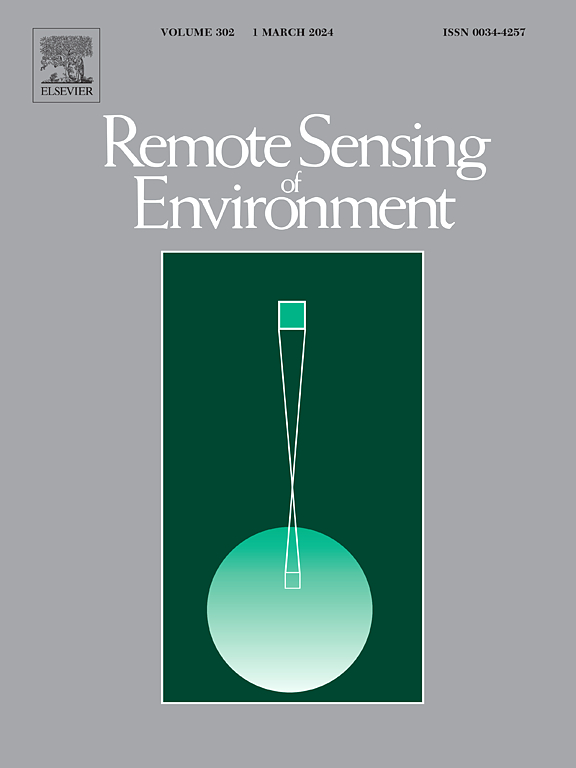Slip surface, volume and evolution of active landslide groups in Gongjue County, eastern Tibetan Plateau from 15-year InSAR observations
IF 11.1
1区 地球科学
Q1 ENVIRONMENTAL SCIENCES
引用次数: 0
Abstract
Landslides stand as a prevalent geological risk in mountainous areas, presenting substantial danger to human habitation. The slip surface (SSF), volume, type and evolution of landslides constitute crucial information from which to understand landslide mechanisms and assess landslide risk. However, current methods for obtaining this information, relying primarily on field surveys, are usually time-consuming, labor-intensive and costly, and are more applicable to individual landslides than large-scale landslide groups. To tackle these challenges, we present a novel method utilizing multi-orbit Synthetic Aperture Radar (SAR) data to deduce the SSF, volume and type of active landslides. In this method, the SSF of landslides over a wide area is determined from three-dimensional deformation fields by assuming that the most authentic direction of the landslide movement aligns parallel to the SSF, on the basis of which the volume and type of active landslides can also be inferred. This approach was utilized with landslide groups in Gongjue County (LGGC), situated in the eastern Tibetan Plateau, which pose grave peril to community members and critical construction along the upstream/downstream of the Jinsha River. Firstly, SAR images were gathered and interferometrically processed from four separate platforms, spanning the period from July 2007 to August 2022. Then, three-dimensional displacement time series were inverted based on Interferometric Synthetic Aperture Radar (InSAR) observations and a topography-constrained model, from which the SSF, volume and type were determined using our proposed method. Finally, the Tikhonov regularization method was applied to reconstruct 15-year displacement time series along the sliding surface, and potential driving factors of landslide motion were identified. Results indicate that 53 landslides were detected in the LGGC region, of which ∼70 % were active and complex landslides with maximum cumulative displacement along the sliding surface reaching 1.5 m over the past ∼15 years. In addition, the deepest SSF of these landslides was found to reach 114 m, with volumes ranging from 1.66 × 105 m3 to 1.72 × 108 m3. Independent in-situ measurements validate the reliability of the SSF obtained in this study. More particularly, we found that the 2018 failure of the Baige landslide (approximately 50 km from LGCC) had caused persistent acceleration to those wading landslides, highlighting the prolonged impact of external factors on landslide evolution. These insights provide a deeper understanding of landslide dynamics and mechanisms, which is crucial when implementing early warning systems and forecasting future failure events.
青藏高原东部公断县15年InSAR观测的滑动面、体积及滑坡体演化
山体滑坡是山区普遍存在的地质风险,对人类居住构成重大威胁。滑坡的滑面、体积、类型和演变是了解滑坡机制和评估滑坡风险的重要信息。然而,目前获取这些信息的方法主要依靠实地调查,通常耗时、费力和昂贵,而且更适用于单个滑坡而不是大规模滑坡群。为了应对这些挑战,我们提出了一种利用多轨道合成孔径雷达(SAR)数据推断活动滑坡SSF、体积和类型的新方法。该方法通过假定滑坡运动的最真实方向与滑坡运动的最真实方向平行于滑坡运动的最真实方向,从三维变形场中确定大范围滑坡的滑动加速度场,并在此基础上推断出活动滑坡的体积和类型。该方法在青藏高原东部贡岳县(LGGC)的滑坡群中得到了应用,该滑坡群对社区居民和金沙江上下游的关键建设构成了严重威胁。首先,对2007年7月至2022年8月期间四个不同平台的SAR图像进行采集和干涉处理。然后,基于干涉合成孔径雷达(InSAR)观测和地形约束模型反演三维位移时间序列,利用该方法确定SSF、体积和类型。最后,应用Tikhonov正则化方法沿滑动面重建15年位移时间序列,识别滑坡运动的潜在驱动因素。结果表明,LGGC地区共发现53个滑坡,其中约70%为活跃的复杂滑坡,在过去的~ 15年里,沿滑动面最大累积位移达到1.5 m。此外,发现这些滑坡的最深SSF达到114 m,体积在1.66 × 105 m3 ~ 1.72 × 108 m3之间。独立的原位测量验证了本研究获得的SSF的可靠性。更具体地说,我们发现2018年白格滑坡(距离LGCC约50公里)的破坏对涉水滑坡造成了持续的加速,突出了外部因素对滑坡演变的长期影响。这些见解提供了对滑坡动力学和机制的更深入了解,这对于实施早期预警系统和预测未来的失败事件至关重要。
本文章由计算机程序翻译,如有差异,请以英文原文为准。
求助全文
约1分钟内获得全文
求助全文
来源期刊

Remote Sensing of Environment
环境科学-成像科学与照相技术
CiteScore
25.10
自引率
8.90%
发文量
455
审稿时长
53 days
期刊介绍:
Remote Sensing of Environment (RSE) serves the Earth observation community by disseminating results on the theory, science, applications, and technology that contribute to advancing the field of remote sensing. With a thoroughly interdisciplinary approach, RSE encompasses terrestrial, oceanic, and atmospheric sensing.
The journal emphasizes biophysical and quantitative approaches to remote sensing at local to global scales, covering a diverse range of applications and techniques.
RSE serves as a vital platform for the exchange of knowledge and advancements in the dynamic field of remote sensing.
 求助内容:
求助内容: 应助结果提醒方式:
应助结果提醒方式:


